What makes Sinigang, a dish with a sour and savory broth, a comfort food in Filipino cuisine? Is it the mix of tamarind, proteins, and veggies that gives it a unique taste? Or is it the emotional bond Filipinos share with this traditional soup? As we dive into Sinigang, we’ll see why it’s more than food—it’s a tradition that unites families.
Sinigang is a beloved Filipino stew made with tamarind, proteins, and veggies. It’s cooked in one pot, making it easy to customize. This dish is a big part of Filipino culture and is loved worldwide.
Key Takeaways
- Sinigang is a traditional Filipino soup known for its sour and savory broth, making it a staple comfort food in Filipino cuisine.
- The dish can be tailored to personal preferences by incorporating different proteins and vegetables, such as pork, seafood, beef, chicken, and tofu, making it a versatile comfort food.
- Tamarind is the key ingredient that imparts the signature sour taste to Sinigang, and its use enhances flavors by adding a balance of sweetness and tanginess, complementing various ingredients in this comfort food.
- Sinigang is often served with steamed rice and can be paired with side dishes like fried fish, lumpia, and salted egg with tomatoes, making it a complete and satisfying comfort food.
- The preparation of Sinigang can involve the use of tamarind powder mix, tamarind concentrate, or tamarind paste, each with its pros and cons in terms of flavor and convenience, allowing for flexibility in preparing this comfort food.
- Sinigang has become an integral part of Filipino cuisine, and its popularity continues to grow, both in the Philippines and around the world, as a beloved comfort food.
What is Sinigang?
Sinigang is a beloved Filipino sour soup or stew. It’s made with meat or seafood like pork, beef, shrimp, or fish. Tamarind, tomatoes, garlic, and onions add to its savory taste.
The dish gets its sour flavor from tamarind. It’s balanced by the sweetness of vegetables and the savory protein.
A Brief Overview of the Dish
Sinigang can be made with various proteins and vegetables. It’s often served with steamed rice. This makes it a staple in Filipino cuisine.
Historical Origins of Sinigang
The exact origins of sinigang are unclear. But it’s thought to have started in the Philippines before the Spanish arrived. Over time, it has evolved, influenced by different cultures.
Variations of Sinigang Across Regions
There are many sinigang variations. For example, Sinigáng na baboy (Pork Sinigang) and Sinigáng sa misô (Sinigang with miso). Each region in the Philippines has its own twist, showing the country’s diverse culture and cuisine.
Sinigang has become famous worldwide. TasteAtlas named it the best soup globally in 2021. It’s also known for its health benefits, making it a favorite for a nutritious meal.
Essential Ingredients in Sinigang
Sinigang is a key dish in Filipino cuisine, known for its variety of ingredients. The ingredients used greatly impact the dish’s flavor and character. In Filipino food culture, the choice of proteins, vegetables, and flavorings is very important.
Primary Proteins Used
Pork, beef, shrimp, and fish are common proteins in Sinigang. Bony cuts of pork, like spare ribs, are preferred for better flavor. Chicken is also an option, catering to different tastes and dietary needs.
Common Vegetables in Sinigang
Many vegetables are used in Sinigang, including sitaw, eggplant, okra, and bok choy. Kangkong and pechay are also added, making the dish nutritious and flavorful. This variety is a key feature of Filipino cuisine.
Key Flavoring Agents
Tamarind is the main souring agent in Sinigang, but guava, green mango, and calamansi can also be used. The choice of flavorings greatly influences the dish’s taste. This makes flavoring a critical part of preparing Sinigang.
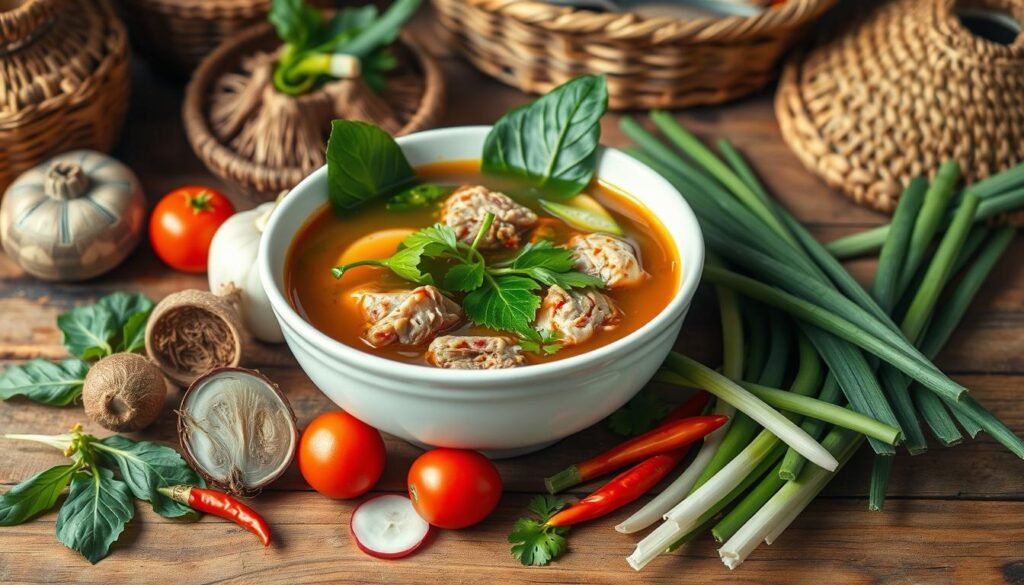
| Ingredient | Quantity |
|---|---|
| Pork spare ribs | 1 ½ lb |
| Tamarind pulp | 45g |
| Long beans | 1 cup |
| Taro root | 2 cups |
The Role of Tamarind in Sinigang
Tamarind is key in Sinigang, giving it a sour taste. You need about 200-300 grams of unripe sampaloc fruit for the broth. Boil the fruit in 6-8 cups of water for 20-30 minutes until it softens.
The sour tamarind broth is balanced by sweet veggies and savory protein. This mix creates a unique flavor. Some say green mango or calamansi can replace tamarind, but it changes the taste a lot.
Here are some key facts about using tamarind in Sinigang:
- 200-300 grams of whole unripe sampaloc fruit is needed to make the tamarind broth
- 6-8 cups of water is used to boil the whole unripe sampaloc fruit
- 20-30 minutes is the boiling time for the sampaloc pods to soften
Store unripe sampaloc fruit outside the fridge if using in two days. Leafy veggies should be added just before serving. This mix of tamarind broth, protein, and veggies makes a delicious, sour soup.
The flavor of Sinigang depends a lot on tamarind. Its sour taste makes Sinigang refreshing and unique. Whether you choose pork, shrimp, or beef, the tamarind broth ties all flavors together, making a tasty, sour soup.
Cooking Techniques for Sinigang
Sinigang is a beloved food in the Philippines. Its cooking techniques are key to its unique taste. This dish highlights the country’s rich culinary history.
There are traditional and modern ways to cook Sinigang. Traditional methods include boiling ingredients in a pot. Modern methods might use a pressure cooker or slow cooker. The goal is to balance sour and savory flavors perfectly.
To get the right tang, use the right souring agents like tamarind or guava. Adjust the seasoning with fish sauce or salt. Fresh, high-quality ingredients like pork or shrimp and vegetables like eggplant, okra, and string beans are essential.
For more on Filipino cuisine and food, check out online guides and cookbooks. They offer recipes and techniques for traditional Filipino dishes like Sinigang.

- Pork or shrimp
- Eggplant
- Okra
- String beans
- Tamarind or guava
- Fish sauce or salt
By following these tips and using the right ingredients, anyone can make a delicious Sinigang. This dish showcases the best of Filipino cuisine and food.
Popular Sinigang Variants
Sinigang is a beloved Filipino comfort food known for its sour flavors. It comes in many varieties, each with its own special taste. Some of these stand out more than others.
Here are some of the most loved Sinigang types:
- Sinigang na Baboy (Pork Sinigang), known for its rich and savory flavor
- Sinigang na Baka (Beef Sinigang), which offers a hearty and comforting experience
- Sinigang na Hipon (Shrimp Sinigang), a lighter and refreshing option
These Sinigang types each have their own unique taste. They all share a common sour taste, thanks to tamarind. This makes Sinigang a favorite in Filipino cooking.
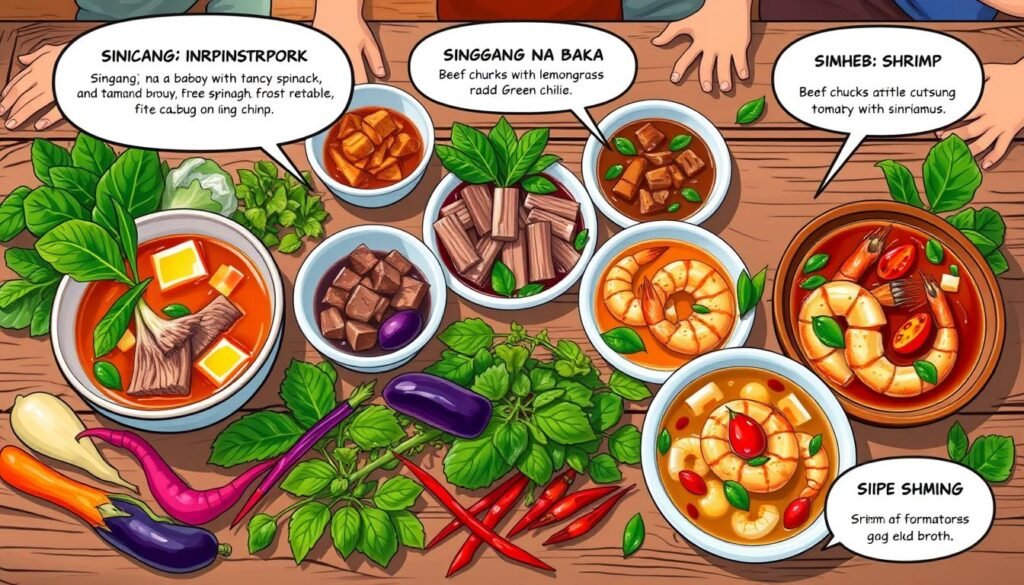
Whether you like the classic pork or beef, or the lighter shrimp, Sinigang is a treat. It’s perfect for those who love something sour and tasty.
Cultural Significance of Sinigang
Sinigang is more than a dish in Filipino cuisine. It stands for warmth, hospitality, and sharing meals together. It’s a favorite at family gatherings and special events, showing the value of being together and enjoying food.
In the Philippines, sinigang is a key dish that unites people. It shows the country’s rich culture and its ability to change and grow. Different regions in the Philippines make it with their own twist, using various meats and souring agents.
Some key points about sinigang’s cultural importance are:
- Family tradition: Sinigang is a staple at family gatherings and special occasions.
- Communal dining: It’s served in a big pot, promoting sharing and socializing.
- Cultural identity: Sinigang is a symbol of Filipino culture and heritage.
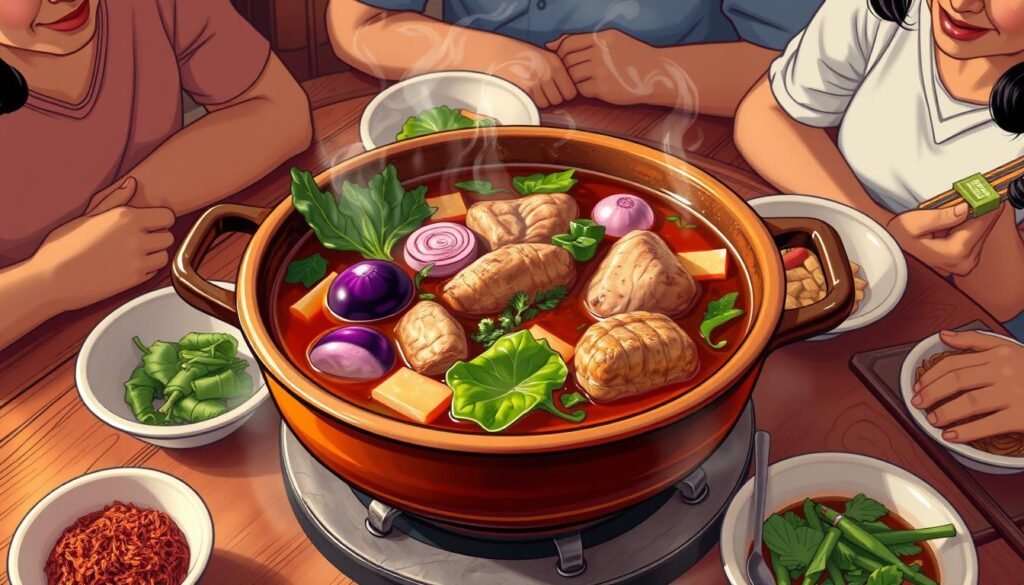
In summary, sinigang is deeply valued in the Philippines. It brings people together and showcases Filipino cuisine. This makes it a cherished part of the country’s food culture.
| Dish | Cultural Significance |
|---|---|
| Sinigang | Warmth, hospitality, and communal dining |
| Adobo | Rich cultural heritage and adaptability |
| Lumpia | Filipino cultural identity and tradition |
Health Benefits of Sinigang
Sinigang is more than just a comfort food. It’s packed with vitamins and minerals thanks to tamarind. This key ingredient is full of vitamin B, vitamin C, and more.
Research shows that ginger in sinigang can help with diabetes. It has compounds that fight inflammation and boost antioxidants. Tomatoes, radish, and taro add even more nutrients, making sinigang a healthy choice.
Studies say sinigang can lower diabetes risk and boost immunity. It’s also good for your vision, skin, and heart. Plus, it’s full of fiber, which is great for digestion and heart health. Learn more on the website about sinigang’s cultural importance.
Here are some key health benefits of sinigang ingredients:
- Tamarind: rich in vitamins and minerals
- Ginger: helps lower blood sugar levels and improve heart disease risk factors
- Tomatoes: high in vitamin C, potassium, and folate
- Radish: detoxifies the liver and stomach, controls damage to red blood cells, and reduces the risk of cardiovascular diseases
- Taro: rich in potassium, calcium, magnesium, phosphorus, folate, and fiber, aiding in reducing the risk of diabetes and improving immunity

Sinigang is not just tasty and sour. It’s also a comfort food that’s good for you. It’s a great choice for a healthy diet.
Sinigang in Filipino Cuisine
Sinigang is a key part of Filipino cuisine, showing the country’s love for food. It’s a dish that was around before the Spanish came. You can make it with many meats and veggies, making it tasty and unique.
The sour taste of Sinigang is loved by many in the Philippines. Over time, people have used different sour ingredients like guava and mango. This makes Sinigang a favorite in the Philippines.
Sinigang’s Place Among Other Filipino Dishes
Sinigang is often eaten with dishes like adobo and lechon. Together, they offer a rich and tasty food experience. This shows how diverse and creative Filipino cooking is.
The Influence of Sinigang on Filipino Palates
The sour taste of Sinigang has shaped Filipino tastes. It’s a common dish in many homes, known for its unique flavor. The use of different sour ingredients also makes it versatile.
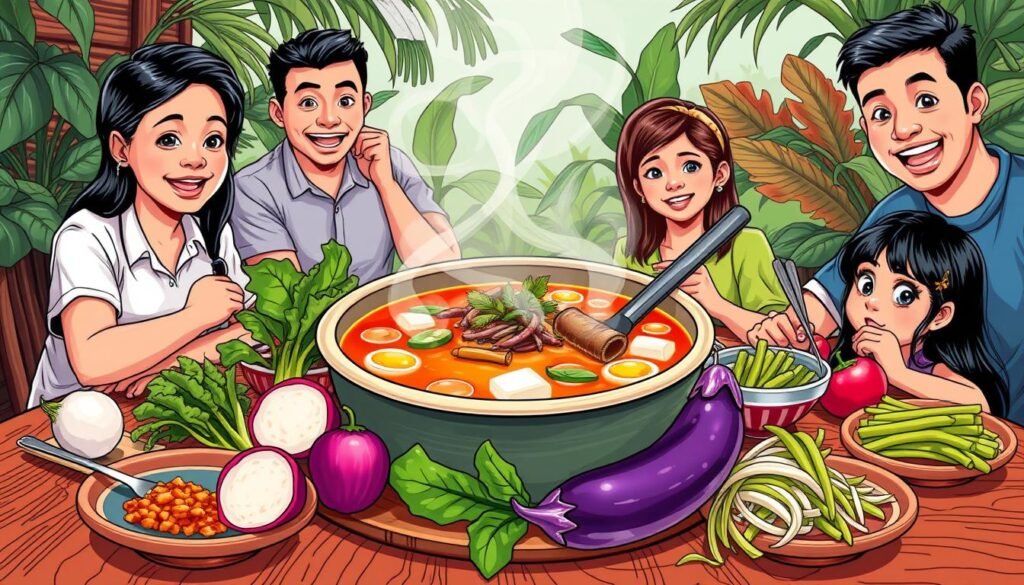
How Sinigang Represents Filipino Cooking Philosophy
Sinigang shows the Filipino cooking philosophy of keeping it simple and using what’s available. It’s made with common ingredients and cooked in simple ways. This simplicity and creativity make Sinigang a favorite in the Philippines.
| Dish | Ingredients | Flavor Profile |
|---|---|---|
| Sinigang | Meat, vegetables, souring agents | Sour, savory |
| Adobo | Meat, vinegar, soy sauce | Savory, slightly sweet |
| Lechon | Pork, spices | Rich, savory |
Sinigang Around the World
Sinigang, a traditional Filipino sour soup, has become famous worldwide. It was named the best soup by the Taste Atlas Awards, scoring 4.63 out of 5 stars. This fame has made sinigang a hit in Filipino restaurants globally, attracting both locals and food adventurers.
Experts on Filipino cuisine say sinigang is a beloved dish at home and in restaurants worldwide. It’s made with proteins like pork, beef, shrimp, or fish, and veggies like okra, eggplant, and tomatoes. Tamarind gives it its unique sour taste.
Global Recognition of Sinigang
Sinigang is now among the world’s top dishes, alongside steak au poivre and pho bo. It’s also won spots in food awards, like the TasteAtlas 2023 Awards. Its popularity has made sinigang a must-try in many Filipino restaurants, sharing Filipino culture with the world.
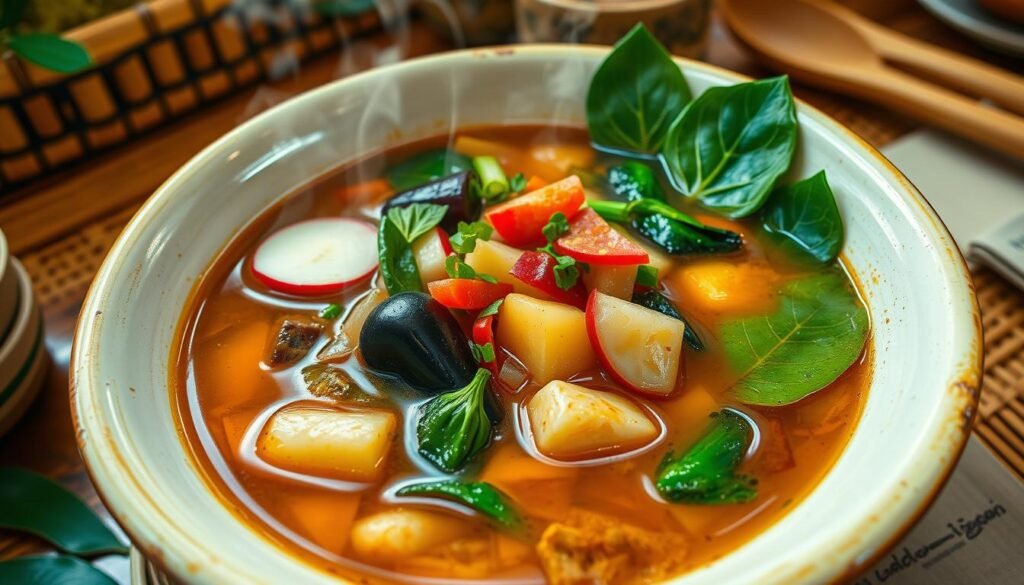
Filipino Communities and Sinigang Traditions
Filipino communities abroad have helped spread sinigang’s fame. Filipino restaurants in places like the U.S., Canada, and Australia often feature sinigang. It’s a staple at special events, highlighting its role in Filipino culture.
Fusion Versions of Sinigang
New versions of sinigang are popping up, mixing traditional flavors with international twists. You can find sinigang na hipon (shrimp), sinigang na baboy (pork), and sinigang na isda (fish). These creative takes on the classic dish attract more fans and boost sinigang’s global appeal.
| Dish | Rating | Award |
|---|---|---|
| Sinigang | 4.63/5 | Taste Atlas Awards |
| Ciorbă de fasole cu afumătură | 4.42/5 | Taste Atlas Awards |
| Shōyu Ramen | 4.38/5 | Taste Atlas Awards |
Family Recipes for Sinigang
Sinigang is more than a dish; it’s a comfort food that unites people. For many Filipinos, it’s a food that brings back memories of family times and special events. Each family has its own special way of making Sinigang.
Some families make their Sinigang very sour, using more sour mix than the recipe calls for. Others add extra veggies like okra, daikon radish, and snake beans for more taste and health benefits. Mommyjheng’s recipe says the secret to a great Sinigang is using the right ingredients and cooking methods.
Here are some tips for a tasty Sinigang:
- Use a mix of souring agents like unripe tamarind, bilimbi, and guava.
- Add taro (gabi) for a creamy and flavorful soup.
- Use pork neck bones for a richer broth.

Sharing family Sinigang recipes helps keep the tradition alive. It lets us pass it down to our future generations. As Teresa Magbanua’s story shows, food is a powerful way to connect with our heritage and culture.
Recommended Side Dishes for Sinigang
Enjoying Sinigang, a traditional Filipino sour soup, is better with the right side dishes. In Filipino cuisine, side dishes balance flavors and textures. Steamed rice is a classic choice, as it neutralizes the sourness.
Other side dishes like pickled vegetables, such as atchara, and grilled or fried dishes like lechon or chicken inasal are great too. They add variety and enhance the flavor of the food.
Try fresh tomatoes, ensaladang talong (grilled eggplant salad), and hilaw na mangga (green mango salad) with Sinigang. They offer a refreshing contrast to the rich, sour flavor of Sinigang, making for a well-rounded and satisfying meal.

In Filipino cuisine, mixing different side dishes with Sinigang is an art. By choosing the right side dishes, diners can enjoy the full range of flavors and textures that Filipino food offers.
The Evolution of Sinigang
Sinigang has changed a lot over time. It started as a simple sour soup with local ingredients. Now, it has many variations, each with its own taste.
New spices and herbs have made Sinigang more interesting. This has led to different versions like Sinigang na baboy, Sinigang na baka, and Sinigang na hipon. Each one uses a different protein in a sour broth.
Today, Sinigang is all about trying new things. Chefs use sour fruits like pineapple and strawberries for unique flavors. There are also vegetarian and vegan Sinigang options for everyone.
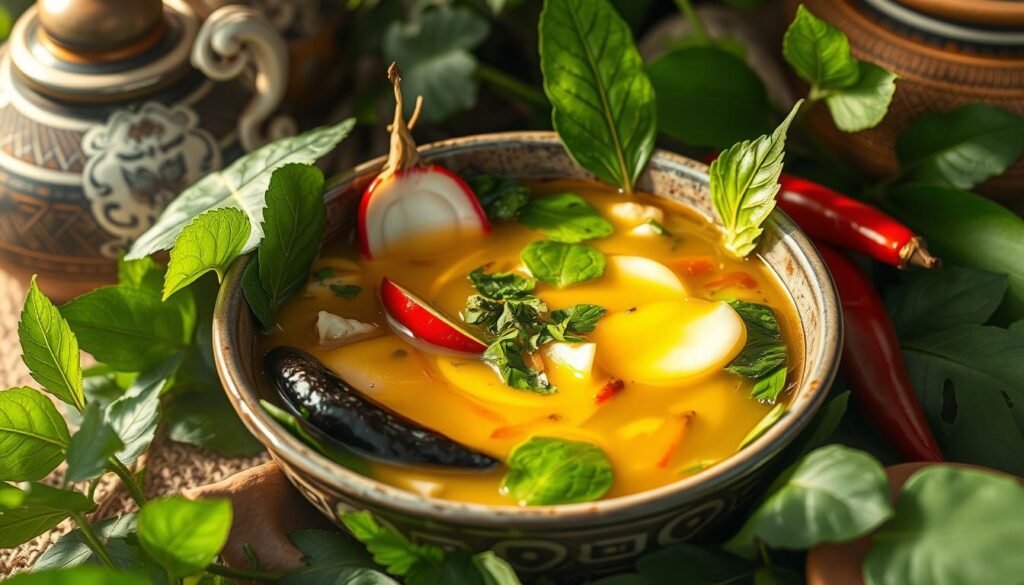
- Sinigang na baboy (pork Sinigang)
- Sinigang na baka (beef Sinigang)
- Sinigang na hipon (shrimp Sinigang)
- Sinigang na isda (fish Sinigang)
In conclusion, Sinigang’s journey shows how versatile it is. From a simple sour soup to a diverse dish loved worldwide, Sinigang keeps surprising us.
| Variation | Protein | Broth |
|---|---|---|
| Sinigang na baboy | Pork | Sour |
| Sinigang na baka | Beef | Sour |
| Sinigang na hipon | Shrimp | Sour |
Sinigang and Its Regional Variations
Sinigang is a beloved Filipino dish known worldwide. Its many regional versions show the country’s rich cuisine. Each region uses different souring agents like tamarind, guava, or calamansi.
In some places, Sinigang is made with pork and veggies. Others use shrimp or fish. The choice of protein and veggies changes a lot, depending on the region and who’s making it.
Some regional Sinigang versions include:
- Sinigang na baboy (pork Sinigang)
- Sinigang na hipon (shrimp Sinigang)
- Sinigang na isda (fish Sinigang)
These variations highlight Sinigang’s diversity across regions. They show how it can fit local tastes and ingredients.
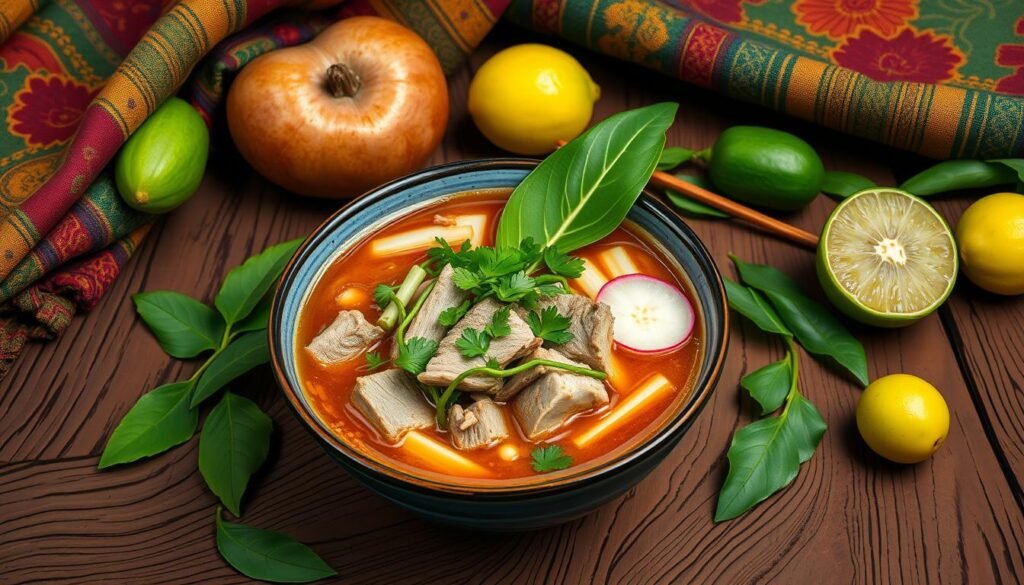
In summary, Sinigang’s many versions reflect the Philippines’ rich food culture. Whether you’re in the Philippines or elsewhere, Sinigang will surely excite your taste buds. It’s a dish that makes you crave more of the Philippines’ tasty food and cuisine.
Famous Sinigang Restaurants in the Philippines
For a real Sinigang taste, check out famous spots like Cafe Juanita, Mesa, and Locavore. They mix traditional flavors with new twists. These places are known for their sour tastes and top-notch ingredients.
Looking for Sinigang in Metro Manila? Restaurants there offer a variety of Sinigang, like Sinigang na Baboy and Sinigang na Bangus. Each dish brings a unique flavor to the classic comfort food.
Here are some famous Sinigang spots to visit:
- Cafe Juanita: Fresh Corned Beef Sinigang with Chorizo
- Mesa: Sinigang na Baboy in Guava and Pineapple
- Locavore: Sizzling Sinigang and Kimchinigang

These restaurants promise a memorable meal. They serve Sinigang with a twist and focus on fresh ingredients. Whether you want something classic or bold, you’ll find a Sinigang dish to love as a comfort food.
Sinigang in Pop Culture
Sinigang is a big part of Filipino pop culture. It’s seen in movies, TV shows, and art. This dish is more than just food; it’s a symbol of Filipino identity.
In Filipino films and TV shows, Sinigang is shown as a comfort food. It brings people together. It’s also used to talk about family, tradition, and cultural heritage. Its ability to adapt makes it a favorite in art and media.
Sinigang’s role in art and media shows its importance in Filipino culture. It’s been featured in many forms of art, like paintings and sculptures. As a symbol of Filipino identity, it continues to inspire artists and media creators.

- Featured in Filipino films and TV shows as a comfort food
- Depicted in art and media as a symbol of Filipino identity
- Used as a plot device to explore themes of family and tradition
In conclusion, Sinigang’s role in pop culture shows its deep meaning in Filipino culture. As a symbol of Filipino identity, it keeps inspiring and influencing artists and media creators. It solidifies its place in the country’s rich cultural heritage.
| Pop Culture Medium | Sinigang’s Representation |
|---|---|
| Films and TV Shows | Comfort food, symbol of Filipino identity |
| Art and Media | Symbol of Filipino culture and heritage |
| Music and Literature | Inspiration for creative works, reflection of Filipino values |
Conclusion: The Lasting Legacy of Sinigang
Sinigang is more than just a dish to Filipinos. It’s a symbol of their culture and heritage. It brings comfort and reminds them of their rich history.
Why Sinigang Will Always Be a Comfort Food
The flavors of Sinigang bring back memories of family and childhood. It nourishes both body and soul. This makes it a beloved comfort food in Filipino homes.
The Role of Sinigang in Preserving Heritage
Sinigang showcases the Philippines’ diverse culinary traditions. It blends Spanish, Asian, and indigenous flavors. Sharing Sinigang with the world helps preserve Filipino heritage and identity.
Looking Ahead: The Future of Sinigang in Filipino Cuisine
The future of Sinigang looks promising. Chefs and home cooks are exploring new ways to make it. Yet, it will always keep its core flavors that Filipinos love.
FAQ
What is Sinigang?
Sinigang is a Filipino comfort food with a sour taste. It’s a tamarind-based soup with proteins, veggies, and flavorings.
What are the common ingredients in Sinigang?
Sinigang usually has a protein like pork, beef, or shrimp. It also includes veggies like tomatoes, onions, and leafy greens. Tamarind is the souring agent.
Why is tamarind so important in Sinigang?
Tamarind gives Sinigang its sour flavor. This tartness balances the soup’s taste.
What are some of the popular variations of Sinigang?
Popular Sinigang types include Sinigang na Baboy (pork), Sinigang na Baka (beef), and Sinigang na Hipon (shrimp).
How is Sinigang traditionally cooked?
Traditionally, Sinigang is simmered in a pot. This lets the flavors mix and the broth become sour. Today, some use pressure or slow cooking.
What is the cultural significance of Sinigang in the Philippines?
Sinigang is a beloved comfort food in the Philippines. It brings families together, enjoyed at gatherings and meals.
What are the health benefits of consuming Sinigang?
Sinigang is healthy because of its veggies and proteins. Its sour taste may also improve digestion and immune function.
How has Sinigang evolved over time?
Sinigang has changed, influenced by foreign cuisines and modern cooking. It now has fusion and regional versions for different tastes.
Where can one find the best Sinigang in the Philippines?
Many top restaurants in the Philippines serve great Sinigang. Famous spots include [insert specific restaurant names and locations].
How is Sinigang represented in Filipino pop culture?
Sinigang symbolizes Filipino culture, appearing in films, TV, art, and media. It represents the Philippines’ unique flavors and traditions.
Source Links
- The Ultimate Sinigang Recipe: A Guide to This Filipino Comfort Food – https://flavoureats.com/the-ultimate-sinigang-recipe-a-guide-to-this-filipino-comfort-food/
- Sinigang For The Soul: Building Community Through #FilipinoFoodStories – https://medium.com/@apasion96/sinigang-for-the-soul-building-community-through-filipinofoodstories-b5c68f08114
- Comforting One-Pot Sinigang (Filipino Tamarind Stew) | Fork & Spoon – https://itsforkandspoon.com/sinigang-filipino-tamarind-stew/
- Sinigang – https://en.wikipedia.org/wiki/Sinigang
- Sinigang – https://panlasangpinoy.com/pork-sinigang-na-baboy-recipe/
- Sinigang na Baboy – https://www.kawalingpinoy.com/sinigang-na-baboy/
- Filipino Sinigang with Pork Ribs – https://hot-thai-kitchen.com/sinigang/
- How To Make Sinigang from Scratch – Jeanelleats Food and Travel Blog – https://jeanelleats.com/sinigang-recipe/
- Sampaloc/Tamarind Broth for Sinigang – Market Manila – https://www.marketmanila.com/archives/sampaloc-tamarind-broth-for-singang
- Pork Sinigang (Filipino Pork in Tamarind Soup) – Salu Salo Recipes – https://salu-salo.com/pork-sinigang-pork-in-tamarind-soup/
- Sinigang na Baboy (Pork Sinigang Recipe) – speedyrecipe.com – https://speedyrecipe.com/sinigang-na-baboy-pork-sinigang-recipe/
- How to Cook Sinigang With Unique Flavors – https://www.knorr.com/ph/tips-and-tricks/how-to-cook-sinigang-regional-flavors.html
- Sinigang na Baboy (Filipino Pork Sinigang Recipe) | Mikha Eats – https://mikhaeats.com/sinigang-na-baboy-filipino-pork-sinigang-recipe/
- Different Types of Sinigang and How to Make This Dish – https://www.jozmahal.com/different-types-of-sinigang-and-how-to-make-this-dish/
- 7 Innovative Sinigang Ingredients to Try at Home – https://www.recipedia.com/en-ph/articles/food-trends/food-lifestyle/innovative-sinigang-ingredients-to-try/
- History of Sinigang – https://taylormaighdlin.wordpress.com/2014/05/12/history-of-sinigang/
- Delicious Sinigang Recipe Origins & Varieties – https://titoboysjerky.com/blogs/history-of-traditional-filipino-food-and-cuisine/discover-the-tastiest-sinigang-recipe?srsltid=AfmBOooCTNvTtzRp_l7ujzYNDwBzPuNtfkQXqu0biPNMTP48ndLWuVX4
- Sinigang Is The Popular Filipino Dish Teeming With Uniquely Sour Notes – Tasting Table – https://www.tastingtable.com/1518377/filipino-sinigang-uses-uniquely-sour-notes/
- ON THE MENU – SINIGANG WITH PORK – The Cooking Project – https://thecookingproject.org/2018/10/menu-sinigang-pork/
- Sinigang na Baboy Recipe: Pinoy’s Favorite – https://hicaps.com.ph/sinigang-na-baboy-recipe/?srsltid=AfmBOop9Oj1x9qcEupugCoHSg8Oik4pVZSv34tq1NX5m-H_UZEJk0LIk
- A Traditional Filipino Dish – Sinigang – https://honestcooking.com/traditional-filipino-dish-sinigang/
- Are You Team Sinigang Or Team Adobo? – https://medium.com/sharing-food/are-you-team-sinigang-or-team-adobo-cf2d1bd11ff6
- Sinigang is the world’s best soup – https://freshoptions.ph/blogs/freshcipes/sinigang-is-the-worlds-best-soup
- A taste of tradition: The history and cultural significance of Sinigang – https://steemit.com/hive-131369/@larapambuan/a-taste-of-tradition-the-history-and-cultural-significance-of-sinigang
- Sinigang na Baboy with Gabi – https://panlasangpinoy.com/sinigang-na-baboy-with-gabi/
- Pork Sinigang with Gabi Recipe – https://pilipinasrecipes.com/pork-sinigang-gabi-recipe/
- 7 Nutri-Sarap Side Dishes for Fried Filipino Food – https://www.knorr.com/ph/recipes/recipe-tips/nutri-sarap-side-dishes.html
- 10 Best Filipino Side Dishes | Newport World Resorts – https://www.newportworldresorts.com/blog-articles/10-best-filipino-side-dishes
- 15 Delicious Filipino Side Dishes To Enjoy – Women Chefs – https://womenchefs.org/filipino-side-dishes/
- Sinigang History: The Unofficial National Dish of the Philippines? – https://foodicles.com/sinigang-history/
- Sinigang: The Ultimate Guide to Philippines’ Favorite Sour Soup – Festive Pinoy – https://festivepinoy.com/sinigang-the-ultimate-guide-to-philippines-favorite-sour-soup/
- Savor the real ‘asim’ of sinigang – https://www.philstar.com/lifestyle/modern-living/2011/06/11/694669/savor-real-asim-sinigang
- Delicious Sinigang Recipe Origins & Varieties – https://titoboysjerky.com/blogs/history-of-traditional-filipino-food-and-cuisine/discover-the-tastiest-sinigang-recipe?srsltid=AfmBOoqupyHiF2QBcuU5ZPLd2Rc-YayMixsxbsfIjgK4lctzOKigRFAY
- The secret to the perfect sinigang – https://thekultura.substack.com/p/the-secret-to-the-perfect-sinigang
- 12 Mukhasim Sinigang Dishes Worth Trying in Metro Manila | Booky – https://booky.ph/blog/sinigang/
- Sinigang in Manila | Eat Your World – https://eatyourworld.com/destinations/asia/philippines/manila/what-to-eat/sinigang/
- Top of the Town – Filipino Comfort Food Sinigang | foodpanda Magazine PH – https://magazine.foodpanda.ph/top-of-the-town-sinigang/
- Sinigang is a Verb – https://meryenda.substack.com/p/sinigang-is-a-verb
- LOLA on Sinigang – Ajinomoto – https://www.cookmunitybyajinomoto.com/lola-on-sinigang/
- Sinigang For The Soul: Building Community Through #FilipinoFoodStories — One Down – https://onedown.media/read/sinigang-for-the-soul-building-community-through-filipinofoodstories
- Filipino Food Culture – https://aithor.com/essay-examples/filipino-food-culture
- The Spanish Influence on Filipino Culture and Language – https://vamospanish.com/discover/the-spanish-influence-on-filipino-culture-and-language/

